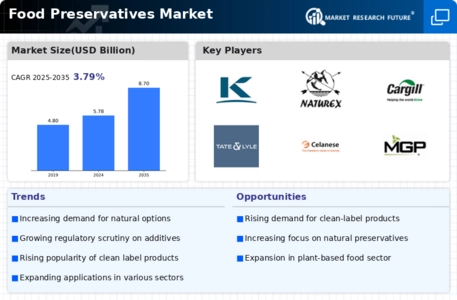Top Industry Leaders in the Food preservatives Market

The food preservatives market is a dynamic arena characterized by an array of players striving to carve their niche in a space driven by the escalating demand for longer shelf life, food safety, and preservation of organoleptic properties.
Strategies Adopted
Strategies adopted by these key players often encompass a multifaceted approach. They focus on developing preservatives derived from natural sources, catering to the rising consumer preference for clean label products. Additionally, companies are investing in technologies that enhance the efficacy of preservatives while minimizing their impact on taste, texture, and nutritional value. Collaborations with food manufacturers to tailor preservative solutions for specific product lines and geographical regions are also prominent strategies. Moreover, sustainability and eco-friendly initiatives are becoming pivotal as consumers demand preservatives that align with their environmental concerns.
Market Share Analysis
Market share analysis in this competitive landscape hinges on several factors. Product innovation, regulatory compliance, pricing strategies, distribution channels, and marketing efforts play crucial roles in determining the market position of preservative providers. Companies that excel in offering a diverse range of preservative solutions while meeting stringent regulatory standards tend to garner larger market shares. Furthermore, their ability to adapt swiftly to changing consumer preferences and industry trends significantly impacts their competitive standing.
Emerging Companies
Amidst the established players, new and emerging companies are entering the fray with novel approaches to food preservation. Start-ups and smaller firms are leveraging technological advancements and scientific breakthroughs to introduce disruptive preservative solutions. Companies like Corbion and Kemin Industries are gaining traction with their focus on natural and clean label preservatives. Their agility, innovative offerings, and responsiveness to market demands position them as potential challengers to established players.
Industry News
Industry news often reflects the dynamic nature of this market. Recent developments indicate a growing emphasis on natural preservatives derived from plant extracts, fermentation processes, or biotechnological advancements. Regulatory shifts and consumer preferences towards clean label products continue to influence companies' strategies and product development initiatives. Additionally, partnerships and collaborations between preservative manufacturers and food producers to develop tailored solutions for specific food categories have been making headlines.
In terms of current company investment trends, there is a noticeable surge in investments directed towards research and development endeavors aimed at creating preservatives that meet evolving consumer demands for healthier and natural alternatives. Furthermore, investments in expanding production capacities, enhancing distribution channels, and strengthening partnerships with food manufacturers are prevalent among key players looking to solidify their market positions.
The overall competitive scenario in the food preservatives market reflects a delicate balance between established giants and nimble newcomers. While established companies leverage their resources, experience, and global presence to maintain dominance, newer entrants challenge the status quo with innovative, sustainable, and natural preservative solutions. The industry continues to evolve, driven by consumer preferences, regulatory changes, technological advancements, and a growing emphasis on sustainability, setting the stage for a vibrant and competitive market landscape.Top of Form
Recent New :
BASF. These established entities wield considerable influence due to their extensive product portfolios, global presence, and robust distribution networks. Their strategies revolve around continuous research and development initiatives to introduce innovative preservative solutions, strategic partnerships with food manufacturers, and mergers and acquisitions to expand their market reach.
Key players dominating this landscape include major companies like
- Cargill, Incorporated (U.S.)
- BASF (Germany)
- DuPont (U.S.)
- Regal DSM (the Netherlands)
- Univar Inc. (U.S.)
- Kemin Industries, Inc. (U.S.)
- Akzo Nobel N.V. (the Netherlands)
- Cosmic S.A. (Belgium)
- Hansen A S (Denmark)
- Brenntag Inc (U.S.)
- Celanese Corp. (U.S.)
- Prinova Group, LLC (U.S.)
- Tate and Lyle PLC (U.K)
- Danisco A/S (Denmark)
- Hawkins Watts Limited (New Zealand)
- Albemarle Corporation (U.S.)
- Kerry Group (Ireland)
- Bowman Daniel Midland (U.S.)
- Corbion Purac (the Netherlands)
- Jungbunzlauer Ag (Switzerland)
- Cognis (Germany)


